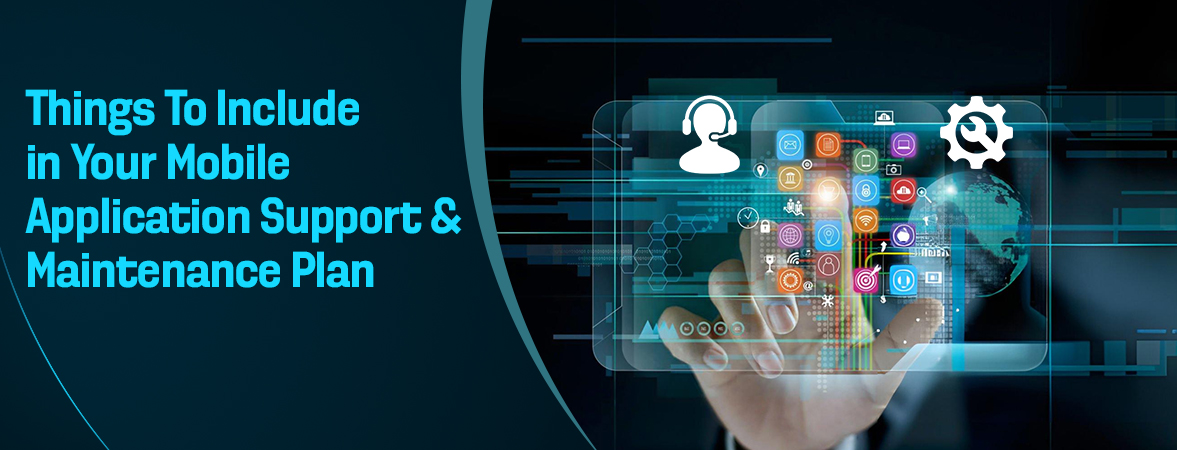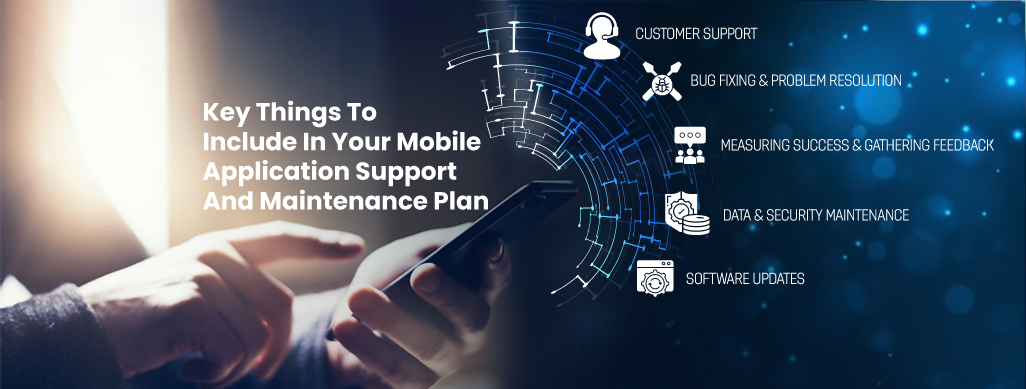
We use cookies to ensure that we give you the best experience on our website.
By using this site, you agree to our use of cookies. Find out more.
This blog discusses the key elements that should be included in such a plan to ensure apps remain updated, secure and effectively supported.

Mobile applications have become an integral part of our daily lives, whether for personal or professional use. From communication and entertainment to e-commerce and banking, apps have revolutionized the way we perform various tasks. However, developing an app is just the beginning of a long journey. Maintaining app quality and supporting users over the app's lifecycle are equally important responsibilities. A well-planned mobile application support and maintenance plan is crucial to deliver seamless experience to users. This blog discusses the key elements that should be included in such a plan to ensure apps remain updated, secure and effectively supported.
Mobile application support and maintenance refers to the ongoing activities required to keep a mobile app functional, secure and updated for users. It involves managing customer support channels to address user issues, fixing bugs and stability issues in a timely manner, rolling out regular software updates and security patches, and ensuring data and infrastructure security. The key goal is to provide a seamless and reliable experience to users across multiple devices and platforms.
An important part of app support is also proactively seeking feedback from customers and measuring engagement metrics to understand pain points. All these activities need to follow documented processes and have assigned roles and responsibilities. A well-defined mobile app support and maintenance plan helps organize these essential post-launch tasks, guides consistent execution, and gives users confidence that their issues will be addressed properly.
It is crucial for businesses to have a dedicated support and maintenance plan in place for their mobile applications. This is because apps require continuous care beyond the initial development and launch phases. Users will expect a consistent and reliable performance. They also look for timely resolutions to issues faced. Without proper planning, support could become disorganized leading to poor user experience and frustration. It is important to schedule important maintenance activities like software updates and security patches regularly to plug vulnerabilities.
Lack of maintenance makes apps prone to bugs and crashes negatively impacting the brand. A documented plan brings in process discipline and ensures responsibilities are clearly defined. It helps allocate necessary resources and track progress optimally. A good support plan builds user trust and satisfaction, improves app quality over time, and maximizes return on investment for applications.
Here are the key things to include in a Mobile Application Support and Maintenance Plan:

Customer support is one of the most important aspects of any mobile application. It is the primary channel through which users will report issues, seek help or clarify queries regarding application use. Therefore, it is crucial to designate robust customer support channels that allow users to reach out conveniently.
Some popular options are email support, in-app support tickets, live chat functions and dedicated phone lines. It is advisable to offer 24/7 support through at least one of these channels to handle critical issues faced by users. The customer support team also needs to be trained adequately to effectively handle different types of queries, from troubleshooting app crashes to explaining features. Standard protocols should also define expected response times for each support channel based on the priority of the issue.
Setting up an in-app support portal is a very effective way to address user issues as it does not require them to switch out of the application. Some important things to include are - an easy way to report issues with screenshot capability, option to view ticket history and status updates, different categories to log problems like bugs, payment errors, account queries etc.
The support team should also strive to resolve issues at the earliest to ensure a smooth experience for users. Providing updates on tickets and recognizing valued users who report bugs assists in building positive rapport. Regular analysis of support queries also helps identify recurring problems and improve app quality over time.
An important aspect of any application support and maintenance plan is efficient resolution of bugs and other problems reported by users. To streamline this, it is important to establish a centralized ticketing or issue tracking system where all support tickets from various channels get logged. The tickets should capture critical details like device, OS version, steps to reproduce the issue and screenshots. This acts as a single source of truth for the development team. All issues also need to be assigned predefined severity levels like critical, major and minor.
Developers must then follow a structured approach of reproducing higher priority bugs, finding the root cause and validating fixes on a staged environment before production deployment. Regular minor releases can be scheduled to push our minor bug fixes. For major bugs affecting significant users, out-of-cycle patches may need to be evaluated.
As part of the maintenance plan, it is also vital to perform root cause analysis of bugs to identify underlying technical or process deficiencies. Common issues reported via customer support must be prioritized. Ensuring versatile testing including cross browser, devices and OS versions can prevent regressions.
Bug fixes and new features should not introduce new problems. Timely communications regarding known issues and resolution status updates will manage user expectations. Metrics like average resolution time and number of open bugs gives insight into support effectiveness. Addressing bugs proactively builds credibility and enhances the overall user experience.
Keeping the application up-to-date with the latest features and enhancements is a key part of any support and maintenance plan. Regular software updates need to be scheduled, whether it is minor bug fix releases or major version upgrades. A standardized update cycle like monthly/quarterly fixes ensures improvements are delivered consistently to users. The development team must also be reactive to include urgent fixes if critical vulnerabilities are discovered.
Similarly, compatibility with platform changes introduced by Apple/Google in their biannual OS updates need to be tested and any requiring code changes need to be addressed. The update process itself should be streamlined with staging environment testing and staged rollouts to monitor performance. Communication to users during each update phase is also important to highlight what's new and address any anticipated issues.
Security updates deserve high priority in the maintenance plan. Almost every new version introduces security protections for new threats. Failing to update apps in a timely manner could expose users to risks. Vulnerability assessments must be conducted by internal/external security researchers and patches released proactively. A secure development lifecycle including measures like input validation, encryption, authentication etc. helps build-in security.
Tracking external OS/library updates and addressing vulnerabilities in dependencies is also important. Outdated apps negatively impact the brand and users. Hence, committing the required resources to keep the application and its underlying technologies up-to-date is a must for any effective support and maintenance plan.
Securely managing user data is a core responsibility for any mobile application. The support plan must address effective procedures to back up application data on a regular basis to cloud servers. Important metrics like backup frequency, recovery time objectives, data encryption techniques, and access controls should be clearly defined.
Equally crucial is conducting security audits and vulnerability assessments periodically through specialized tools or third-party experts. Identified vulnerabilities need timebound remediation plans. The development process also requires secure coding best practices and scrutinizing third party components for weaknesses. User education about secure usage, strong passwords, two-factor authentication if available helps. Compliance with standards like GDPR involving privacy policies, consent management, information access must be ensured.
A robust incident response system is equally important to quickly address any security breaches. Detection capabilities via monitoring tools, penetration testing and reporting mechanisms need to be established. A well-defined protocol should spell out roles and responsibilities during security incidents, initial containment procedures, evidence collection, root cause analysis, future prevention strategies and timely communications.
User trust and engagement can take a significant hit in case of unaddressed vulnerabilities or data leaks. Hence, data security must be ingrained in practices through a defense-in-depth approach involving people, processes and technologies. Continued enhancements help maintain a secure environment aligned with the evolving threat landscape.
To continuously improve the application and support services, it is critical to implement mechanisms to gather insightful user feedback. Comprehensive analytics help understand app usage, pinpoint bugs and crash-prone areas. Tracking metrics like number of active users, average session times, subscription renewals give a sense of engagement and retention. Surveys with customized questions sent occasionally and via app store ratings/reviews provide qualitative feedback.
Incentivizing participation boosts response rates. The data gathered must be assimilated to draw actionable insights. Opportunities could range from improvements to sticky features or necessary deprecations. Gathering metrics on support queries also aids in evaluating pain points and prioritizing efforts.
Support is deemed valuable when issues get timely resolutions to users' satisfaction. Measuring support quality parameters provide objective performance management. Things like average and first response times, resolution rates, escalation frequencies are important to track. Customer satisfaction scores via post-resolution surveys indicate how effectively issues get addressed.
Comparing metrics over time shows progress and trouble areas. Validating fixes deployed via support tests provides confidence. Benchmarking against industry standards helps set achievable goals. Communicating metrics to stakeholders demonstrates accountability. Regular review of learnings assists necessary changes to processes, resources or tooling. An evidence-based approach is vital to continually refine application maintenance.
Having a comprehensive yet executable support and maintenance plan is necessary to sustain user trust and satisfaction with any mobile application. Regularly measuring different parameters helps assess areas for improvement. While technical bugs and performance issues will be inevitable at times, addressing them promptly and keeping users informed maintains a positive relationship. Backed by dedicated resources and process control, the plan helps apps deliver value for long term. With mobile technology continuing to evolve rapidly, flexible support maintains competitive edge for businesses. Proactive maintenance ensures apps remain aligned to rising industry standards as well. Prioritizing user experience goes a long way in building loyalty and engagement.
Leave a Comment
Your email address will not be published.